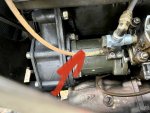It’s a Harbor Freight air pressure gauge so maybe not the best tool.Just spit balling here so lets start with the gages. They are wrong or you have an over pressure in the system. Most LDT's seem to be running around 30 psi idle and 60 psi high idle. Now that is the specs for minimum performance levels. Now the LDS pump has specs that are higher and over 70 psi. for high idle and idle. Yea it was said if you have some or 4-7 psi fuel pressure at the bleed screw between the fuel filters that everything should be good for pushing fuel through the head back to the tank. While the engine can run with the over pressure valve that is in the T fitting open on the secondary fuel filter wondering if this might be you problem. There are a couple of ways of checking the over pressure valve. If you gage is correct then the over pressure valve would be open well before 80 psi. I am not going to look through the TM for the open pressure of the over pressure valve but mid 70's is what I am thinking.
The high speed pressure was me grabbing the fuel rod with the cover off. Might have been a little extra ambitious with the rev.
I have pulled the regulator I think you are talking about in the secondary filter? A spring loaded basket under the extra bolt? It looked clean but I sprayed it with some brake cleaner and acetone and re-installed.
Today I pulled the pump out again to retrace everything I have messed with since it started acting up. It WAS starting on its own (with extra throttle) before I pulled tank and filters.
I am wondering why there is seepage at the tank hanger gasket with only 10 gallons in the tank. I think the fitting at the top of the hanger (flare fitting inside tank) might be leaking / spraying the gasket making it leak and seep (also introducing air maybe).
Then it started raining on me. I might mess with it tomorrow.


